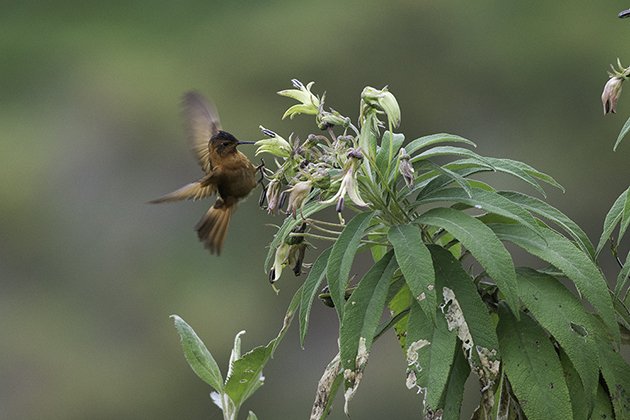
Hugh Powell is a science editor at the Cornell Lab of Ornithology. Hugh, who years ago helped me find my first Pauraque in the Rio Grande Valley, visited Peru as part of the 2014 World Birding Rally, where he stopped thinking of himself as an experienced birder. This is his first contribution to 10,000 Birds. :
Come to Peru, they said. There’s this World Birding Rally that’s going to blast across 1,500 kilometers of northern Peru. Eight days with 20 of the world’s top birding guides looking for some 1,000 species and three dozen endemics. There will be spatuletails, and you will marvel at them. There will be Andean rocks, and they will have cocks on them. We’ll go on a pelagic trip and you can wave at albatrosses. There may not be any kinglets, but there will be tyrannulets. You can see as many hummingbird species as the folks at Magee Marsh are seeing warbler species—during 25 minutes on a Sunday afternoon. There will be tanagers wearing masks, hoods, scarves, spangles, collars, and crowns. You can see the world’s smallest passerine and the Western Hemisphere’s biggest flying bird.
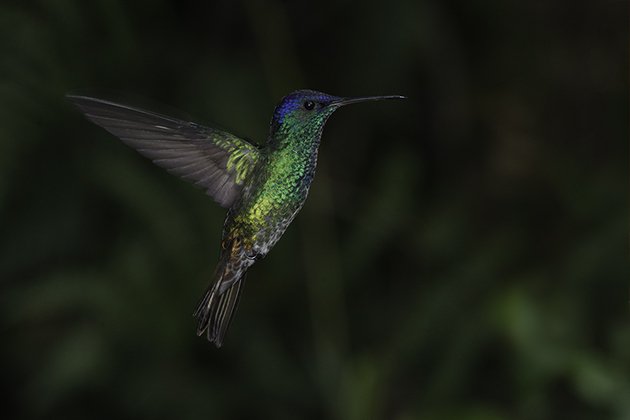 Golden-tailed Sapphire by Alfredo Fernandez
Golden-tailed Sapphire by Alfredo Fernandez
They didn’t say, you’ll be chasing along behind the best birders on the planet and trying in the 5 a.m. darkness to write down the names of the birds they’re whispering as they point out three faint vocalizations at once.
They didn’t say, when you hear owls calling from an Utcubamba roadside at noon, bear in mind that Rich Hoyer can produce a full range of geographically appropriate pygmy-owl vocalizations without so much as moving his lips.
They didn’t say, these people will pay as much attention to the Dull-colored Grassquits, Plain-colored Seedeaters, Drab Hemispinguses, and Plain-tailed Warbling-Finches as they do to the Elegant Crescentchests and Rufous-crested Coquettes. But it still won’t be enough for you to catch up.
They didn’t say, when a rally participant describes a bird as “out in the open, nice view,” you should double the distance at which you can normally identify birds and then look for a shadow moving behind a tangle of epiphytes.
No warning was issued about the stretch of 73 plates in the field guide, from where the trogons leave off to where the flycatchers begin, that present a desert of unfamiliarity to you, hapless North American traveler. We’re talking about earthcreepers, streamcreepers, palmcreepers, leaftossers, barbtails, prickletails, spinetails, treerunners, woodhaunters, and thornbirds.
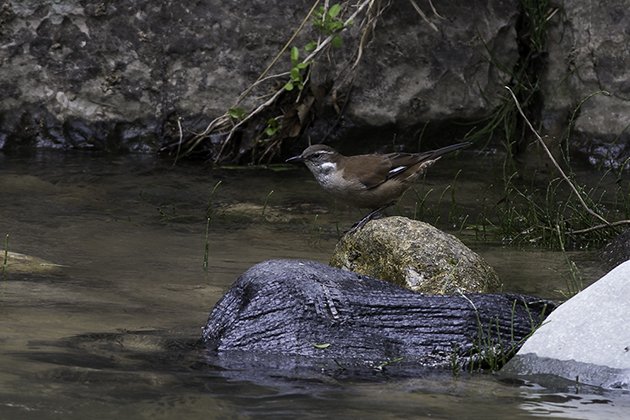 White-winged Cinclodes by Alfredo Fernandez
White-winged Cinclodes by Alfredo Fernandez
Also left out: that horneros, canasteros, and cinclodes are not underappreciated South American musical instruments, they are birds that one should be familiar with before entering the country.
Neither did they say, when you see a flycatcher, take out your field guide and set it in a comfy spot. It is about the same size as a travel pillow and if you are lucky you will dream of a nice straightforward genus like Empidonax.
I was not offered any historical perspective, such as that apparently even the great nineteenth century taxonomists with their immense Victorian vocabularies lacked the resources to properly name the birds of Peru. Oh, they tried—Peru’s birds are lined, barred, fasciated, streaked, striated, striped, collared, undulated, lunulated, scaled, and speckled. They are black, gray, slaty, dusky, cinereous, leaden, plumbeous, blackish, bluish-slate, saturnine, mouse-colored, tawny, ochre, rusty, russet, rufous, rufescent, chestnut, fulvous, and brown. Also variegated.
Eventually they began treating whole bird groups as if they were the intermarrying scions of English aristocrats, and that’s why you have page upon hyphenated page of bush-tyrants, chat-tyrants, ground-tyrants, tit-tyrants, pygmy-tyrants, shrike-tyrants, shrike-vireos, shrike-tanagers, tit-spinetails, and tyrant-manakins. And I, like some dowager countess in a birding vest, am expected to know each one’s family at a glance and greet them by name.
I looked at the World Birding Rally the way a music lover imagines being backstage after hours in the juke joints of the 20s, where the jazz greats stayed up late and pulled out all the stops. Here, four teams of bird guides—Field Guides, Surbound Expeditions, Sunbird/Wings, and Birding Ecotours—set out each morning at 5 a.m. and birded without respite until 7:30 p.m. for a week. At times it was as if they were birding in a different key.
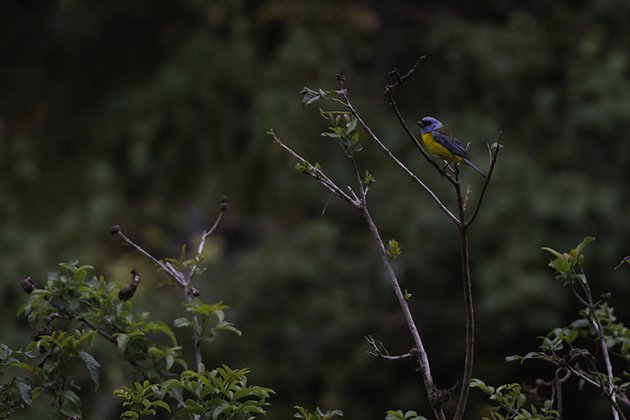 Blue-and-Yellow Tanager by Alfredo Fernandez
Blue-and-Yellow Tanager by Alfredo Fernandez
I kept up the pace pretty well for the first two hours on the first day, when I rode along with the Birding Ecotours team. The Peruvian Screech-Owl they found hooting at Bosque Pomac? I heard that. Then it got light.
On the third day I drove with the Field Guides team to 3,200 meters. In the U.S. you could be forgiven for wearing crampons at that elevation, but in the Andes it’s only about halfway up. We stood in the shrubby edge of someone’s backyard and were mobbed by Titlike Dacnises and Shining Sunbeams. Rose Ann Rowlett and Richard Webster, who have been leading trips here for about 20 years, said things like, “In the top of this tree are two Rufous-webbed Bush-Tyrants. They look like grayish flycatchers but they’ll show rufous in the wings when they fly.”
Put it this way, the least experienced person on the Field Guides team—on his first trip to Peru—was Terry Stevenson. You may have heard of him; he lives in Kenya and holds the Big Day world record.
Each time I traveled with the Sunbird/Wings team, the pace seemed to quicken. “I’m not a competitive person, but I believe if you’re going to do something you should do it properly,” Steve Howell told me. Then he said quite cheerfully that if I was the last person to get back to the van after a stop, they would leave me.
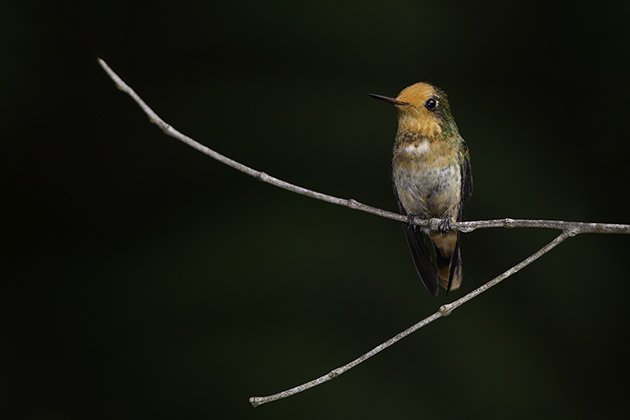 Rufous-crested Coquette (female) by Alfredo Fernandez
Rufous-crested Coquette (female) by Alfredo Fernandez
As the rally tore through its itinerary, the species piled up. Each morning at 4 a.m. I felt like my brain had spent the previous night shoveling snow out of its driveway only to have it buried anew. On the first day the teams saw a combined 177 species. By the end of the second day the cast of characters was just as large, but completely different.
On the third day we squelched through muddy fields at 3,500 meters and we could see our breath; by the fourth day we were down in the Marañon Valley picking our way around organpipe cactus and looking for inca-finches (an entire genus endemic to Peru). The sun was so strong I could hear the photons slamming into the ground. And yet that evening we were back in the highlands and eating a warm soup made with three kinds of potatoes.
On the fifth day I saw a Marvelous Spatuletail drifting among the flowers at Hoembo. Its long tail rackets swayed like the outstretched arms of a dancer, and I couldn’t think about anything else the rest of the afternoon. The next day the deluge of species intensified—several teams recorded more than 200 species that day alone. And only then did we reach the lowlands, where the real diversity is.
By the end, the Sunbird/Wings team took the trophy with 588 species. Field Guides were runners-up with 575. Surbound and Birding Ecotours rounded out the field with 537 and 520 species, respectively. All in all, the teams recorded 777 species in 7.5 days of birding.
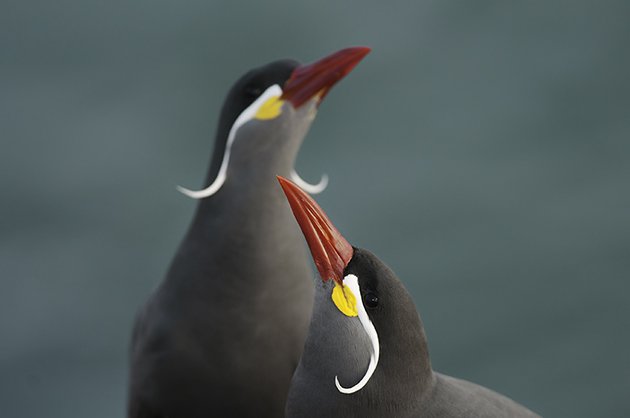 Inca Terns by Alfredo Fernandez
Inca Terns by Alfredo Fernandez
The Peruvian communities we passed through were charming and welcoming. In places like Laquipampa, Leymebamba, Conga, Limon, and Morro La Calzada we were met with singing, dancing, and tables spread with local foods. It was a gesture of how sincerely this still-poor region of Peru wants to share its natural wealth and beauty with visitors.
All I can say is, I can’t think of another time when being utterly humbled was quite so much fun. Just plan to spend a little longer than eight days seeing your 500+ species. I’d even recommend hiring a guide—but for God’s sake don’t try to keep up with 20 of them.
The day after the rally, I slept in until 5 a.m. and then joined the folks from Surbound Expeditions (including 10,000 birds’ own Alfredo) for a final morning of birding. They found an Andean Cock-of-the-Rock lek, and we watched the big birds fire themselves across a misty clearing like flaming cannonballs. Then we headed down the road. There were a lot of birds still to look at.
More about the Rally:
- See more photos on the World Birding Rally Facebook page
- Read James’s account of the 2012 Birding Rally and Alfredo’s account of the 2013 Birding Rally
- The Royal Sunangel Looks as Impressive as It Sounds – Cornell Lab blog
- The Strange Endemics of the Tumbesian Region – Nature Travel Network
- In the Valley of the Endangered, Endemic White-winged Guan – Cornell Lab blog
- Scads of Storm-Petrels on Pre-Rally Pelagic – Nature Travel Network
- Meet the teams: The World Birding Rally teams are composed of tour leaders from four companies: Birding Ecotours (South Africa, led by Duan Biggs); Wings/Sunbird (U.K./U.S., led by Rich Hoyer); Surbound Expeditions (Florida, led by Alfredo Begazo); and Field Guides (Texas, led by Rose Ann Rowlett).
- Many thanks to Rally organizer Manuel Bryce and to sponsors PromPeru, Inkaterra, LAN, Casa Andina, and Cajamarca Travel.
 The Sunbird/Wings team celebrates with Rally director Manuel Bryce. Left to right: Rich Hoyer, Jake Mohlmann, Manuel Bryce, Gustavo Bautista, Paul French, Steve Howell. Photo by Hugh Powell.
The Sunbird/Wings team celebrates with Rally director Manuel Bryce. Left to right: Rich Hoyer, Jake Mohlmann, Manuel Bryce, Gustavo Bautista, Paul French, Steve Howell. Photo by Hugh Powell.
Bird photos by Alfredo Fernandez. Sunbird/Wings photo by Hugh Powell.













Thanks for your post. An amazing experience and great photos… especially the Rufous-crested Coquette and the Inca Terns!
Excellent account! Truly a great post.
I could not have said any better Hugh. Excellent post!
The other post-links at the bottom of the post are equally awesome.
Reading about the Rally makes want to back!!